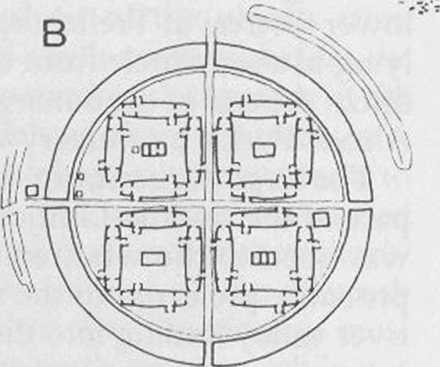51 (229)
96 The Viking Age in Denmark
‘Slavonian’ pottery, madc howcvcr with local clay. In addition, a single coin and a couplc ofweights have been found, while a few pieccs ofjewellery and sonie glass beads ultimately point to western Europę. The site might be intcrpreted as a market place with sonie craft production and be seen as an eastern Danish equivalent of the permanent and regulated towns of Hedeby and Ribe. The Iow wali is a fencing of the territory - which was morę than twice the size of the central settlement at Hedeby - rather than a means of defence.
A possibly similar site lies at Lynaes in north Sjadland.78 In addition, many of the craft and even trading activitics of the towns also took place in the large Trelleborg fortresses of the tenth century, but probably on 3 morę cxclusive basis.
E. Fortresses andfortifications
The impressive Trelleborg-type fortresses of the tenth century, with their strict plan, ring walls and blocks of identical halls, are tra-ditionally considered to have served only military purposes (PI. I and Fig. 28).77 A careful investigation of the Fyrkat site, in north Jylland, however, has revealed that this is only part of the picture.78 Rather, the fortresses were planned military sites, perhaps not dissimilar in function to the fortresses of‘burh’-type of King Alfred’s England in the latc ninth century.79 In shape, the Danish sites have striking parallels among the south-west Holland ring walls, like Oost-Souburg; its datę, unfortunately, is unclear but it seems to have been in existcnce at least by 1000, though it was without houses until the eleventh century.80 The structures of the Dutch site differ from the Danish ones, but the symmetrical lay-out is also characterised here by straight, plank-covered axis streets, Crossing each other at right angles, and leading through four gates in the rampart. Earlier ring forts in Denmark are but poor ‘proto-types’ for the Trelleborg-type, as for example the ninth-century Lembecksburg on the Fóhr island, off the west coast of south Jylland.81 The rampart of Lembecksburg is ten metres high, the diameter 1(X) metres, making the site rather similar in size to a Frankish fort of the same period, with parallels, tor instance, in Holstein. It may perhaps have been connected with the mid-ninth-century Danish fiefof Rurik, an exiled pretender to royal power in Denmark, backed by the Franks (Chapter2 B). Other morę modest sites may also datę from the early Viking Age, but norie display the symmetry of the Trelleborg-type.
In terrns of the ring wali alone, the Trelleborg tortresses, Aggersborg on the northern shore of the Limtjord in north Jylland, Fyrkat in north-cast Jylland, near present-day Hobro, and Trelleborg itself, on west SjaTland, have contemporary parallels in the Non-nebakken rampart at Odense and probably at Arhus too. The Arhus
|
r-T T-> |
i |
r-r | ||||
|
c |
. . | |||||
|
r-r ‘ | ||||||
s #


Figurę 28 Fortresses of the Trelleborg-type. A = Aggersborg (north Jylland). 13 = Fyrkat (north Jylland). C = Trelleborg (west Sjaelland). Notę cemetcries. Scal 1:4(XX). (After Olsen et al.)
Wyszukiwarka
Podobne podstrony:
96 (91) 186 The Viking Age in Denmark Sporup (Mujler-Willc 1976, 21) Thumby-Bienebek C S (Muller-Wil
57 (213) 108 The Viking Age in Denmark Platę IV. Silvcr and copper dccorated spurs, length about 21
58 (195) 110 The Viking Age in Denmark Platę VI. Sample from late tenth-century silver-hoard at Taru
60 (189) 114 The Viking Age in Denmark Platc X. Ship-sctting and runestonc (on smali mound) at Glave
62 (179) 118 The Viking Age in Denmark Plato XIV. Iron tools from a tenth-ccntury hoard atTjclc, nor
63 (170) 120 The Viking Age in Denmark % Platę XVI Pagc with illustration of an English manuscript f
64 (171) 122 The Viking Age in Denmark Figurc 30 Distribution of wealth in three cemeteries as measu
66 (160) 126 The Viking Age in Denmark have becn fouhd (Figs 32-3).7 They stem from thc same provinc
68 (153) 130 The Viking Age in Denmark two tortoise bucklcs to reprcsent wornen of high standing, th
69 (151) 132 The Viking Age in Denmark heavy cavalry burials, fincr wcapon graves of thc simple type
70 (150) 134 The Viking Age in Denmark cemetcry at Lejre on Sjaelland a dccapitatcd and ticd man was
74 (134) 142 The Viking Age in Denmark 5C~ł silver 800 900 kxx) A.D. Figurę 37 Fluctuations in che r
75 (129) 144 The Viking Age in Denmark Figurę 38 Average weight ofthesilver-hoardsofthe period 900 t
27 (504) 48 The Viking Age in Denmark Europcan meteorological data for earlier per
29 (466) 52 The Viking Age in Denmark We have already mentioned the expansion of grasses, and it is
30 (454) 54 The Viking Age in Denmark touch, so the political developmcnt we have described in previ
31 (444) 56 The Viking Age in Denmark pig SO- A horse B 50- 50 cattle 50" sheep (Qoat) Figurę 1
32 (433) 58 The Viking Age in Denmark and from a rurąl scttlemcnt, Elisenhof, less than fifty kilome
78 (124) 150 The Viking Age in Denmark Figuro 41 Danish coins, c. 800 to 1035 A.D. (1) = ‘Hcdeby’ co
więcej podobnych podstron